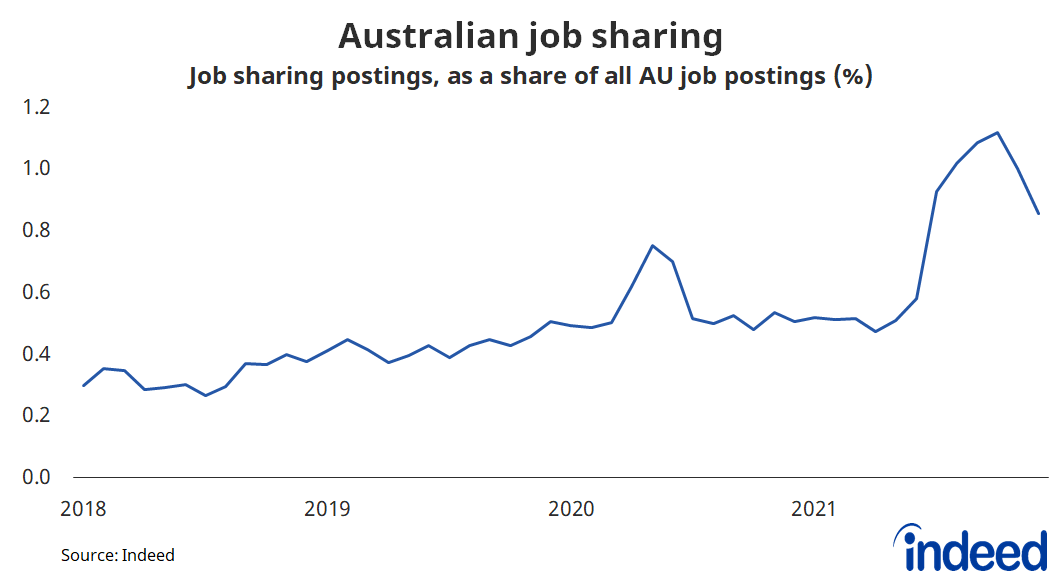Flexible work has fast become the norm in many industries, and it won’t be going away anytime soon. But some employers still struggle to attract and retain top talent. Could job sharing be the answer?
Let’s say you’re hiring for a new role, but there is more than one standout candidate – two, in fact, seem to fit the bill nicely. Traditionally, you’d end up recruiting one candidate and part ways with the other.
But an alternative approach that’s gradually increasing in popularity in Australia is to hire both candidates under a flexible working arrangement. This is a concept known as job sharing.
Put simply, job sharing is when one job is performed by more than one person. According to Kate Furey, Careers Insights Specialist at Indeed, it usually happens in one of two ways.
“The first is when two employees share the same workload, performing the same tasks on different days of the week,” she says. “Other job sharing arrangements will see two employees share the same job, but take responsibility for separate duties within the role.”
Job sharing gains traction
New data from Indeed suggests that Australians’ interest in job sharing increased during the pandemic.
It found that the percentage of new job postings on Indeed mentioning ‘job sharing’ or associated keywords made up1.1 per cent of all postings in October 2021. While that sounds small, it represents a 115 per cent jump compared with the first half of the year.
That number dropped to 0.9 per cent by year’s end, however it’s still higher than 2018 figures (see graph below).

The data found that job sharing keywords were most common in industries such as project management (3.1 per cent of job postings), civil engineering (2.9 per cent), electrical engineering (2.6 per cent), nursing (2.4 per cent) and architecture (2.4 per cent).
Many of these industries lend themselves more easily towards job sharing due to the collaborative nature of day-to-day work duties, according to Indeed.
Although these figures are still quite small in the broader scheme of things, the uptick in the data points towards a telling trend among the modern workforce. Such results also don’t accommodate for examples of workplaces where job sharing is already in action.
Two heads better than one
So job sharing is becoming more popular, even if it’s not hugely prevalent just yet. Furey believes this is indicative of the changing times we live and work in.
“It’s likely that job sharing has become more prominent because it allows employers to retain employees during times of economic hardship and increased personal responsibilities,” she says.
Job sharing arrangements have the potential to be of immense value for employers, she adds, stating that some of the benefits include:
-
- Better work-life balance. “A flexible work schedule with reduced hours and less responsibility makes it easier for employees to reduce work-related stress, which in turn contributes to greater job satisfaction.”
- Greater team inclusion. “Flexible work schedules support greater participation in the workforce, particularly among women, people with disabilities and older Australians.”
- Improved work outcomes. “Job sharing results in better quality control because each partner can devote more attention to each of their responsibilities and can support each other in finding and correcting errors.”
- It’s handy during a pandemic. Job sharing “provides a backup when one employee is sick or has to quarantine in the event of COVID-19.”
Such outcomes are not simply a surface-level sweetener; they could actually be critical to the future success of organisations.
“We’re in a competitive job seekers’ market right now,” says Furey. “Businesses need to be open to more flexible work practices if they want to secure top talent.”
Rosalind Dixon, professor of Law at the University of New South Wales (UNSW), proposed new ways to split roles in a 2020 UNSW report titled ‘Reimagining Job Sharing‘.
She envisioned a multi-dimensional approach to the practice along three axes.
The first axis, intergenerational sharing, is a split between employees at different career stages, which helps a senior employee reduce their workload and their junior to gain experience.
The second is flexible time-based sharing, which looks at the role through an atypical division, such as a 20-80 per cent split.
Lastly, vertical sharing leaves the decision making to the more senior partner.
“We’re in a competitive job seekers’ market right now. Businesses need to be open to more flexible work practices if they want to secure top talent.” – Kate Furey, Careers Insights Specialist at Indeed
This approach not only opens up job sharing to more people, but allows for increased training and mentoring opportunities, along with transmission of knowledge – an important form of insurance for organisational succession planning.
There are two other elements to job sharing that can be factored in: islanding, which is project-based sharing, and twinning, which is a true sharing of the whole role.
Islanding could be a good way to introduce job sharing, with twinning being the end goal, says Dixon.
“In some roles, there’s more likely to be an emphasis on islanding, with a small amount of twinning for cases of sickness, absence or holidays,” she says. “For people who are stretched to capacity, having someone skilled step in and take over one portfolio can be really valuable.”
HR could also empower job share partners to select each other.
“Some people may jointly apply by putting their service forward as a job share package,” says Dixon.
Job sharing in action
So how do employers ensure they effectively utilise job sharing and avoid pitfalls?
According to Furey, employers should prioritise clear planning for this novel working arrangement.
“To ensure job sharing works smoothly for the partners and the broader team, it’s crucial that the role and responsibilities for both job sharers are made clear from the start,” she says.
One employer who has implemented job sharing in the wake of COVID-19 is Catalyst Education, an educational institution that provides services to a number of registered training organisation (RTOs) subsidiaries in early childhood, school-aged, and aged and disability care.
“Job sharing means we can distribute our caseload across training teams so they’ve got flexibility and work-life balance,” says its CEO Jo Asquith.
It’s also about increasing exposure to different areas of the business, she adds. Trainers will often move across different RTOs and new starters will be matched with mentors.
“Someone who’s been working for the organisation for a longer period of time will often be paired with an emerging employee, so there’s a hierarchical, experience-based mentor in the job share arrangement,” says Asquith.
“I’m very passionate about retaining people, so the more cross-disciplinary experience we’re able to provide to our staff, the better chance we have of keeping them on.”

It’s essential to plan things effectively to ensure the arrangement succeeds, says Furey.
“Common examples of where job sharing can go wrong include when job share partners simply aren’t compatible, or when one partner’s outputs are a lot higher or lower than the other, which can then result in divisions around pay and benefits,” she says.
To this end, the importance of clear communication between the job sharers and broader team is critical.
“The hours and expectations need to be made clear from the outset to avoid tension and tasks slipping through the cracks,” says Furey.
“Similarly, establishing how salary and holidays will be split, what happens on sick days, how work will be evaluated and how performance reviews will take place, all needs to be done at the outset.
Another thing to bear in mind is people’s pay grades.
“If it’s a single role that’s being jobshared at the same salary level, working to the same position description, you have to be very cognisant that one person isn’t working at a higher level, with more responsibility but the same pay,” says Asquith.
For Catalyst Education, handovers are the most challenging part of job sharing arrangements.
“With job sharing, you either have two people doing the same role, and they have to pick up where the other left off,” she says. “Or you can split the job into projects, which means you can divvy up the responsibilities quite neatly and almost make two part-time roles.”
In Asquith’s experience, the answer lies somewhere in the middle.
“You have to have some continuity in a role, but equally, you don’t want to spend half the day in handover,” she says.
Furey adds: “Leaders and HR should consider introducing certain systems and technology, such as shared email and/or voicemail, an instant messenger app, and end-of-day reports to facilitate clear communication and sharing of tasks.”
Have you facilitated or been a part of a job sharing arrangement before? Let us know what worked (and didn’t work) in the comment section below.
A portion of this article first appeared in the July 2021 edition of HRM Magazine.
Learn more about adapting to changing business needs and future-proofing your company with job analysis and organisational design short courses from AHRI.

